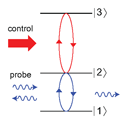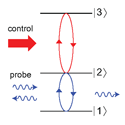Turning to the dark side
Under the right conditions, quantum interference of different pathways for excitation of energy levels in an atom can lead to electromagnetically induced transparency (EIT). When this happens, an otherwise optically active atomic transition is converted into a “dark state” that does not absorb photons, making the atomic medium transparent to light. This phenomenon has been demonstrated experimentally over the past two decades in atomic and molecular gases, solid-state materials, and microscopic systems such as quantum dots. Now, Abdufarrukh Abdumalikov and colleagues at RIKEN and NEC Nano Electronics Research Labs in Japan and Loughborough University in the UK report in Physical Review Letters their success in achieving EIT in a macroscopic artificial atom.
Although feasible, obtaining strong coupling of electromagnetic modes and individual molecules or quantum dots is difficult, so structures made with superconducting circuits in the form of transmission lines are a possible approach. The system studied by Abdumalikov et al. consists of a micron superconducting loop, broken by Josephson junction devices, which exhibits a ladder of atomlike energy levels with transition frequencies in the microwave range. Application of a control signal coupling two energy levels induces EIT, as observed in measurements of reflection and transmission of a probe signal. With modulation approaching , the EIT effect in a macroscopic artificial atom may find use as a switchable microwave mirror. – David Voss





